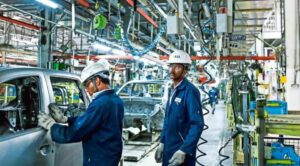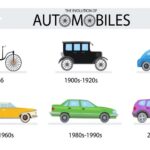Automobile: The Latest Auto News You Need to Know Automotive-2025
Current Developments in the Automotive Sector
The automotive sector is seeing transformative changes driven by technological advancements and evolving market demands. Among the most prominent trends is the surge in electric vehicle (EV) development. Automakers are channeling substantial resources into creating more efficient and affordable EVs, spurred by rising consumer interest and stricter emissions standards globally. This push is not only about meeting regulations but also about catering to a growing demographic that prioritizes sustainability in their purchasing decisions.
Artificial intelligence (AI) and machine learning are revolutionizing the industry in multiple ways. AI is enhancing vehicle performance and safety, while also streamlining manufacturing processes. For instance, predictive maintenance powered by machine learning algorithms can foresee potential issues before they become serious problems, thereby reducing downtime and maintenance costs. Additionally, AI is optimizing supply chain logistics, making production more efficient and cost-effective.
Connectivity is another area experiencing rapid advancements. Modern vehicles are increasingly equipped with smart technologies that enable real-time data exchange, remote diagnostics, and advanced infotainment systems. This trend towards connectivity is paving the way for more sophisticated autonomous driving capabilities, which are gradually being integrated into new models. While fully autonomous cars are not yet mainstream, features like adaptive cruise control and automated parking are becoming standard in many vehicles.

The shift towards sustainable materials is also noteworthy. Car manufacturers are exploring innovative materials such as recycled plastics and bio-based composites, aiming to reduce the environmental footprint of their production processes. This effort is part of a broader trend towards sustainability that is reshaping the entire industry, from design to manufacturing to end-of-life recycling.
Hydrogen fuel cell technology is another exciting development. While still in its early stages compared to battery-electric vehicles, hydrogen fuel cells offer a promising alternative for achieving zero emissions, particularly for larger vehicles and long-distance travel. Several automakers are investing in research and development to make this technology viable and cost-effective in the near future.
The rise of mobility as a service (MaaS) is also transforming the automotive landscape. With urbanization and changing consumer preferences, there is a growing shift from traditional car ownership to flexible, on-demand mobility solutions. Companies are developing integrated platforms that combine various modes of transport, from ride-sharing and car rentals to public transit, into a seamless user experience. This trend is expected to reduce traffic congestion and lower emissions in urban areas.
Lastly, regulatory changes and government incentives are accelerating the transition towards greener technologies. Policies aimed at reducing carbon emissions are encouraging automakers to innovate and offer more eco-friendly options, making the market increasingly competitive. These changes are crucial in steering the industry towards a more sustainable future.
Breakthroughs in Vehicle Design
Recent years have seen significant strides in vehicle design, with a strong emphasis on creating more sustainable and efficient automobiles. The use of innovative materials is at the forefront of these advancements. Manufacturers are increasingly turning to materials such as recycled plastics and plant-based composites. These materials are not only eco-friendly but also contribute to lighter vehicle weights, which can enhance fuel efficiency and overall performance.
Aerodynamics plays a crucial role in vehicle efficiency, particularly for electric vehicles where extending the range is paramount. Engineers are dedicating substantial effort to designing sleeker, more aerodynamic shapes that reduce drag. Advances in computational fluid dynamics (CFD) are enabling designers to refine aerodynamics with a level of precision that was previously unattainable. The result is vehicles that can travel farther on a single charge or tank of fuel, providing a more practical solution for consumers.
In addition to aerodynamics, weight reduction is another critical area of focus. Lightweight materials such as carbon fiber and aluminum are being incorporated more extensively into vehicle structures. These materials offer high strength-to-weight ratios, improving both safety and performance. The use of these advanced materials helps in reducing the overall weight of the vehicle, which directly impacts fuel efficiency and emissions.
Interior design is also undergoing a transformation. The use of sustainable and high-quality materials inside the cabin is becoming more common. Innovations like vegan leather, recycled fabrics, and natural fibers are being utilized to create luxurious yet environmentally conscious interiors. These materials not only provide a premium feel but also align with the growing consumer demand for sustainability.
Technological integration is another exciting area in vehicle design. The incorporation of advanced infotainment systems, augmented reality displays, and enhanced connectivity features are transforming the driving experience. Modern dashboards are becoming more intuitive, offering drivers easy access to navigation, entertainment, and vehicle diagnostics. This level of integration is making vehicles more user-friendly and enhancing overall driver satisfaction.
The exterior design is seeing a shift towards more futuristic and bold aesthetics. LED lighting systems are being integrated into vehicle exteriors, providing better illumination and adding a modern touch to the design. These lighting systems are not only energy-efficient but also enhance safety by improving visibility during night driving.
Moreover, modular design concepts are gaining traction. These designs allow for easier customization and upgrades, enabling consumers to personalize their vehicles according to their preferences. This approach is also beneficial for manufacturers, as it streamlines production processes and reduces costs.
Overall, the breakthroughs in vehicle design are making automobiles more efficient, sustainable, and enjoyable to drive. These advancements reflect the industry’s commitment to innovation and its response to the evolving needs and preferences of consumers.
News from Major Automotive Exhibitions
The automotive world is always abuzz with excitement during major exhibitions, where top brands unveil their latest models and concepts. This year, several prominent brands have released new models that are set to redefine their respective segments. These include cutting-edge SUVs with hybrid powertrains and luxury sedans that offer advanced autonomous features.
In addition to new models, these exhibitions often showcase groundbreaking concepts that hint at the future of the industry. From innovative electric trucks to urban mobility solutions, these concepts highlight the creativity and technological prowess of today’s auto manufacturers. These exhibitions serve as a platform for brands to demonstrate their commitment to innovation and sustainability.
Automotive exhibitions are not just about showcasing new models; they also provide a glimpse into future trends. This year, there has been a noticeable focus on electric and hybrid vehicles, reflecting the industry’s shift toward greener alternatives. Several brands have introduced electric concept cars that promise longer ranges and quicker charging times, addressing some of the key concerns of potential EV buyers.
Another significant trend is the increasing emphasis on connectivity and smart technology. Many of the new models featured at these exhibitions are equipped with advanced infotainment systems, real-time data exchange capabilities, and enhanced safety features. These innovations are transforming vehicles into more than just modes of transportation; they are becoming integrated, intelligent systems that enhance the driving experience.
Moreover, the exhibitions have highlighted advancements in autonomous driving technology. While fully self-driving cars may still be a few years away from becoming mainstream, the features being introduced are gradually paving the way for this future. Enhanced driver-assistance systems, automated parking, and adaptive cruise control are becoming more sophisticated and reliable, making roads safer and driving more convenient.
Sustainable materials and innovative design have also taken center stage at these events. Manufacturers are increasingly showcasing vehicles that use recycled and bio-based materials, contributing to the overall sustainability of the automotive industry. These materials not only reduce the environmental impact of vehicle production but also offer new possibilities in terms of design and functionality.
Furthermore, mobility as a service (MaaS) has been a recurring theme. Exhibitions have featured new concepts that integrate various modes of transport, providing flexible, on-demand mobility solutions. These platforms aim to reduce traffic congestion and lower emissions, particularly in urban areas, by offering alternatives to traditional car ownership.
In summary, major automotive exhibitions this year have provided a comprehensive look at the current and future state of the industry. With a strong emphasis on sustainability, connectivity, and advanced technologies, the showcased innovations promise to shape the automotive landscape for years to come.
Effects of Worldwide Policies on Cars
Changes in emissions regulations are pushing manufacturers to adopt cleaner technologies. Many countries are implementing stricter standards, requiring automakers to reduce their carbon footprints. As a result, the industry is witnessing an accelerated shift toward electric and hybrid vehicles.
To encourage this transition, several governments are offering incentives for hybrid and electric vehicles. These incentives include tax credits, rebates, and reduced registration fees, making it more attractive for consumers to choose environmentally friendly options. These policy changes are crucial in driving the global shift towards a more sustainable automotive future.
Progress in Vehicle Technology
Advancements in vehicle technology are reshaping the automotive industry at an unprecedented pace. One key area of focus is the incorporation of smart technologies, transforming vehicles into more intelligent and interactive systems. These smart technologies include features like real-time navigation and remote diagnostics, which significantly enhance the driving experience and vehicle maintenance.
In-car voice assistants are another innovative feature becoming increasingly common. These assistants can perform a range of tasks, from adjusting climate controls to navigating routes and even making phone calls, all through simple voice commands. This hands-free functionality not only enhances convenience but also improves safety by allowing drivers to stay focused on the road.
Enhanced safety systems are also a major area of development. Advanced driver-assistance systems (ADAS) are being integrated into more vehicle models, offering features like adaptive cruise control, lane-keeping assist, and automatic emergency braking. These systems use a combination of sensors, cameras, and radar to monitor the vehicle’s surroundings and assist the driver in avoiding potential hazards. By reducing the likelihood of accidents, ADAS technology is making driving safer for everyone on the road.
Electric vehicle (EV) technology continues to advance, with improvements in battery life and charging infrastructure. New battery technologies are being developed to extend the range of EVs, making them more practical for everyday use. Fast-charging networks are expanding, reducing the time it takes to recharge an EV and making long-distance travel more feasible. These advancements are critical in addressing one of the primary concerns of potential EV buyers.
Moreover, the integration of renewable energy sources into vehicle technology is gaining traction. Solar panels on car roofs, for instance, can provide additional power, extending the range of electric vehicles and reducing dependence on external charging sources. This innovative approach not only enhances efficiency but also aligns with global sustainability goals.
Connectivity is another domain witnessing rapid progress. Modern vehicles are increasingly equipped with internet connectivity, enabling a range of functions from real-time traffic updates to remote software updates. This connectivity ensures that vehicles remain up-to-date with the latest features and improvements, enhancing both performance and user experience.
Augmented reality (AR) displays are also emerging as a transformative technology in the automotive sector. AR can project important information onto the windshield, such as navigation directions and hazard alerts, allowing drivers to access critical data without taking their eyes off the road. This technology enhances situational awareness and contributes to a safer driving experience.

Artificial intelligence (AI) is playing a crucial role in advancing vehicle technology. AI algorithms are being used to develop more sophisticated autonomous driving systems. While fully autonomous vehicles are still in development, many new cars now feature semi-autonomous capabilities. These systems can handle tasks like highway driving and parking, making the driving experience more convenient and reducing driver fatigue.
Vehicle-to-everything (V2X) communication is another emerging technology that promises to revolutionize road safety and traffic management. V2X allows vehicles to communicate with each other and with infrastructure, such as traffic lights and road signs. This communication can provide drivers with real-time information about road conditions, traffic jams, and potential hazards, enabling them to make more informed decisions.
The integration of blockchain technology in the automotive industry is also on the rise. Blockchain can enhance vehicle security by providing a tamper-proof record of a vehicle’s history, including maintenance and ownership changes. This technology can also facilitate secure transactions for car sharing and other mobility services, ensuring transparency and trust between users.
Lastly, advancements in material science are contributing to the development of more durable and lightweight vehicles. New composite materials and alloys are being used to build car components that are both strong and lightweight, improving fuel efficiency and reducing emissions. These materials also enhance vehicle safety by providing better crash protection.
Overall, the progress in vehicle technology is making automobiles more connected, intelligent, and efficient. These advancements are not only enhancing the driving experience but also contributing to a safer and more sustainable future for the automotive industry.



